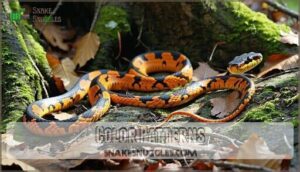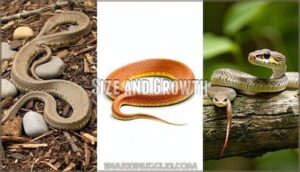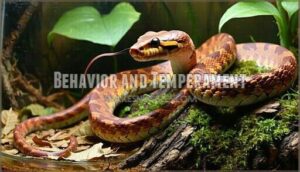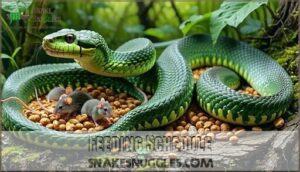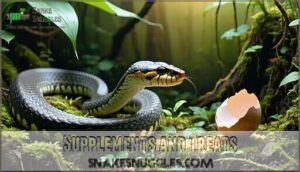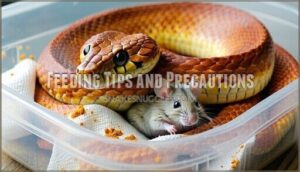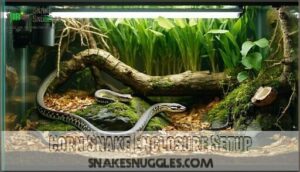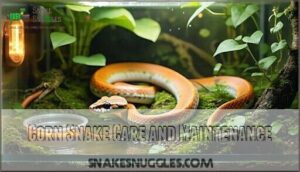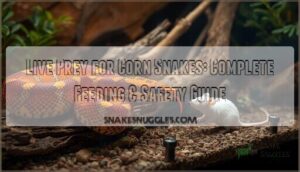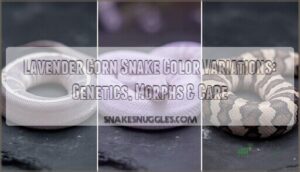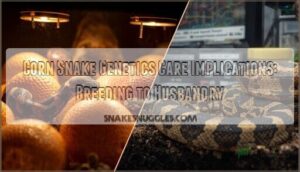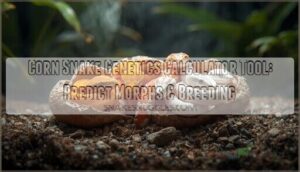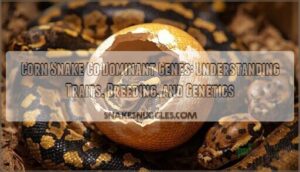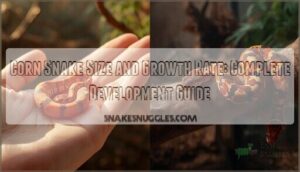This site is supported by our readers. We may earn a commission, at no cost to you, if you purchase through links.
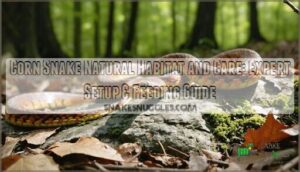
These docile constrictors adapt well to captivity, requiring a 40-gallon tank with temperatures between 75-85°F, 40-60% humidity, and aspen substrate.
Feed juveniles weekly and adults every 10-14 days with appropriately-sized frozen-thawed rodents.
They’re excellent beginner pets due to their calm temperament and straightforward care requirements.
Corn snake natural habitat and care knowledge helps you replicate their wild environment for ideal health.
Understanding their specific temperature gradients, hiding preferences, and seasonal behaviors reveals essential setup details that can make the difference between surviving and thriving.
Table Of Contents
- Key Takeaways
- Corn Snake Natural Habitat
- Corn Snake Physical Characteristics
- Corn Snake Diet and Nutrition
- Corn Snake Enclosure Setup
- Corn Snake Care and Maintenance
- Frequently Asked Questions (FAQs)
- What is the natural habitat for a corn snake?
- How to make a corn snake habitat?
- What does a corn snake need to thrive?
- What is the habitat of the corn snake?
- How do corn snakes reproduce?
- Are corn snakes venomous?
- Can corn snakes live with other reptiles?
- How much do corn snakes cost?
- Do corn snakes hibernate in captivity?
- Can corn snakes be housed together safely?
- Conclusion
Key Takeaways
- You’ll need a 40-gallon tank minimum with secure ventilation and proper substrate depth (2-3 inches) to replicate their southeastern woodland environment.
- Maintain temperature gradients of 75-85°F with a basking spot at 90°F, plus humidity levels between 50-70% for optimal health and shedding.
- Feed juveniles weekly and adults every 10-14 days with appropriately-sized frozen-thawed rodents that don’t exceed 1.5 times your snake’s thickest body section.
- Handle your snake 2-3 times weekly for 10-15 minutes to build trust, but wait 48 hours after feeding and watch for stress signals like rapid tongue flicking.
Corn Snake Natural Habitat
You’ll find corn snakes thriving across the southeastern United States, from North Carolina’s forests to Florida’s wetlands, where they’ve adapted to diverse habitats including woodlands, grasslands, and even urban areas.
Their natural range extends west to Louisiana and Kentucky, with introduced populations now established in the Bahamas and Caribbean islands.
Geographic Distribution
Throughout the southeastern United States, you’ll discover corn snakes thriving in remarkably diverse environments.
Their geographic distribution spans from North Carolina to the Florida Keys, showcasing incredible habitat diversity and regional variations that demonstrate nature’s adaptability.
Here’s what makes their distribution remarkable:
- Climate influence shapes their range, favoring warm, humid southeastern regions
- Population density peaks in Florida while decreasing northward into cooler territories
- Eastern United States boundaries extend from southern New Jersey to Louisiana
- Conservation status remains stable due to their exceptional adaptability
Adult corn snakes need at least 40 gallons for their terrarium.
Native Range
Corn snakes call the southeastern United States their true home, spanning from North Carolina down to the Florida Keys.
Their native range extends west through Louisiana and reaches north into Kentucky, with southeastern habitats providing ideal conditions year-round.
| State Region | Climate Factors |
|---|---|
| North Carolina to Florida | Warm, humid subtropical zones |
| Louisiana to Kentucky | Temperate with seasonal variation |
| Florida Keys | Tropical maritime climate |
Regional abundance peaks in Florida’s diverse ecosystems, while habitat diversity allows adaptation from pine-oak forests to rocky hillsides.
US distribution shows these adaptable serpents thriving in woodlands, grasslands, and even urban edges where rodent populations flourish.
Introduced Areas
Beyond their native southeastern US range, corn snakes have established Bahamas populations and Virgin Islands communities through accidental cargo transport and pet escapes.
These invasive species now threaten local wildlife through direct predation and habitat destruction. Spread prevention efforts focus on monitoring and rapid response to new sightings.
Corn snakes are considered a controlled pest animal in some regions due to these risks.
- Bright orange snakes slithering through Caribbean mangroves where they don’t belong
- Native lizards and birds suddenly disappearing from previously stable island ecosystems
- Cargo ships unknowingly carrying stowaway eggs in plant shipments
- Pet store escapees adapting quickly to tropical island environments
Human Impact on Ecosystems
Human activities have dramatically reshaped corn snake environments across the Southeast.
Habitat destruction from urbanization and agriculture has eliminated nearly 40% of prime pine forests since 1950. Road construction fragments remaining habitats while causing direct mortality – surveys document up to 10 roadkills per mile annually in some areas.
Pollution effects from pesticides accumulate in snake tissues, reducing reproductive success and prey availability. Climate change has raised regional temperatures 1.2°C since 1970, shifting suitable habitat ranges northward.
Conservation efforts now protect additional forest areas and create wildlife corridors, reducing vehicle collisions by 58% where implemented.
Corn Snake Physical Characteristics
You’ll immediately recognize corn snakes by their distinctive orange, red, and brown saddle patterns outlined in black that resemble kernels of corn.
These beautiful reptiles grow from tiny 8-inch hatchlings into impressive 3-6 foot adults, with females typically reaching larger sizes than males over their 15-25 year lifespan, making them a notable species due to their distinctive appearance.
Color Patterns
Wild corn snakes display striking color patterns that serve as natural camouflage in their southeastern habitats.
You’ll notice their signature orange, brown, or red saddle-shaped markings bordered by black, resembling corn kernels. This color variation helps them blend into forest floors and rocky terrain.
Through selective breeding, captive populations now showcase dozens of pattern morphs with unique combinations. The genetic basis of these traits allows breeders to create everything from solid colors to intricate designs.
Whether you’re interested in wild-type specimens for authentic corn snake habitat displays or exotic morphs for your collection, understanding these physical characteristics helps you appreciate why corn snake care focuses on proper corn snake morphs selection.
Size and Growth
Your tiny corn snake starts life at just 8-12 inches but transforms dramatically through consistent growth patterns.
Understanding their development helps you provide proper corn snake care throughout their journey.
Here’s what to expect during their size and growth phases:
- Hatchling Size: Newborns measure 8-12 inches and weigh roughly 6-8 grams
- Growth Rate: First-year snakes gain 12-18 inches with proper feeding schedule
- Adult Length: Mature snakes reach 3-6 feet, with females slightly larger
- Sexual Dimorphism: Females average 4.5 feet while males reach about 4 feet
- Weight Variation: Adults weigh 1-2 pounds depending on genetics and nutrition
Most reach full size by age three through steady development in proper corn snake habitat conditions.
Behavior and Temperament
Your corn snake’s docile reptiles nature makes them perfect companions once they settle in.
These calm temperament snakes display fascinating snake behavior patterns that reflect their wild origins.
| Behavior Type | Wild Instinct | Captive Expression |
|---|---|---|
| Nocturnal Hunting | Active nighttime predator | Evening exploration periods |
| Solitary Nature | Lives alone except breeding | Prefers individual space |
| Sensory Cues | Chemical detection via tongue | Investigates new scents |
| Ambush Predation | Strike-and-constrict hunting | Quick feeding responses |
| Adaptability | Survives diverse environments | Adjusts to enclosure changes |
Handling corn snakes regularly builds trust and reduces stress responses.
Their behavior and temperament improve dramatically with consistent, gentle interaction.
You’ll notice tail rattling when they feel threatened, but this defensive behavior fades as they recognize you as safe.
Lifespan and Health
Your captive corn snake will likely enjoy 15-20 years with you, while wild counterparts face shorter lifespans of 6-8 years due to predation and environmental challenges.
Preventative care and regular veterinary attention dramatically impact longevity factors in corn snake care. As a non-venomous constrictor, they pose no threat to humans.
Key potential ailments to monitor:
- Respiratory infections from poor temperature or humidity control
- Parasites causing weight loss and appetite changes
- Scale rot from inadequate substrate or cleaning habits
Understanding genetic predispositions and maintaining proper reptile health care guarantees your snake stays healthy throughout its impressive lifespan.
Corn Snake Diet and Nutrition
Proper nutrition forms the foundation of corn snake health, requiring careful attention to feeding schedules and prey selection throughout your snake’s life.
You’ll need to adjust meal frequency and prey size as your corn snake grows, while understanding the basics of constrictor feeding behavior guarantees successful long-term care.
Feeding Schedule
Understanding when to feed your snake makes all the difference in their health and happiness.
Hatchlings need meals every 7 days to fuel rapid growth, while juveniles can wait 7-14 days between feedings.
Adult corn snakes only require food every 14-21 days due to their slower metabolism.
Make certain you have the right prey size available for each feeding.
Prey Frequency depends on your snake’s Size Progression – younger snakes burn energy faster than mature adults.
Meal Timing should remain consistent to establish routine and reduce Regurgitation Risks.
During Seasonal Changes, particularly winter months, adults may refuse food for weeks without concern.
Monitor your corn snake diet carefully, adjusting the feeding schedule based on body condition rather than strict calendar dates.
Prey Items and Size
Selecting appropriate prey guarantees your corn snake’s health and safety. Choose frozen-thawed rodents that match your snake’s body width for easy swallowing.
- Pinkie mice: Perfect starter prey for hatchlings
- Adult mice: Standard diet for mature corn snakes
- Small rats: Suitable for larger adult specimens
- Prey variety: Occasionally offer quail or other small mammals
- Size rule: Never exceed 1.5 times your snake’s thickest section
These are often sold as frozen reptile feeders. This corn snake diet approach prevents choking while providing proper nutrition through your snake feeding guide.
Supplements and Treats
Nutritional variety transforms a standard corn snake diet into something richer and more engaging. While whole prey rodents deliver complete nutrition, occasional supplements and treats can enhance your snake’s health and prevent dietary monotony.
Consider these enriching options:
- Reptilinks offer convenient nutrition while encouraging natural feeding behaviors
- Quail eggs provide calcium-rich treats that many corn snakes readily accept
- Calcium dusting on prey every few feedings supports bone development
Vitamin supplements aren’t necessary if you’re providing UVB lighting and varied prey. However, breeding females benefit from light calcium dusting to support egg production. Snakes also need vitamin D3 for absorption of calcium.
Store supplements properly and replace them every six months since vitamins naturally degrade over time. Remember that moderation is key—over-supplementation can cause health problems. Stick to treating your snake once every four to six feedings to maintain ideal nutrition without disrupting their balanced corn snake diet.
Feeding Tips and Precautions
Your feeding routine can make or break your corn snake’s health, so let’s nail the basics. Never offer prey larger than 1.5 times your snake’s thickest body section. Use feeding tongs to prevent accidental bites and maintain safe handling practices.
Feed frozen thawing prey in a separate container to prevent substrate ingestion. Selecting the right frozen rodent size is vital for their diet. Watch for regurgitation signs and adjust your feeding schedule accordingly.
| Age Group | Feeding Frequency | Prey Size Guidelines |
|---|---|---|
| Hatchlings | Every 5-7 days | Pinkie mice |
| Juveniles | Every 7-10 days | Fuzzy to adult mice |
| Adults | Every 10-14 days | Adult mice to small rats |
Monthly supplement dusting provides essential nutrients for a healthy diet.
Corn Snake Enclosure Setup
Creating the perfect enclosure setup replicates your corn snake’s natural southeastern United States habitat while meeting their specific captive care needs.
You’ll need to balance temperature gradients, humidity levels, and enrichment features to guarantee your snake thrives in captivity, ensuring a setup that includes enrichment features.
Tank Size and Layout
Your corn snake needs proper space to thrive. Enclosure security starts with a minimum 40-gallon tank featuring secure locks and mesh ventilation.
Looking at the paragraph about tank space and security requirements, here’s an engaging blockquote in the same tone:
**Space equals security—your snake’s happiness starts with proper room to roam.
Adults require dimensions allowing full body extension plus climbing room. Substrate depth of 2-3 inches supports natural burrowing behavior while accommodating arboreal needs with climbing branches.
Position multiple hide boxes throughout the layout to create secure zones and reduce stress in your snake’s environment.
Temperature and Lighting
The right temperature and lighting setup forms the backbone of successful corn snake care. You’ll need to establish a thermal gradient ranging from 75°F on the cool side to 85°F on the warm side, with your basking spot reaching 90°F for ideal digestion.
Essential temperature and lighting requirements:
- Create temperature gradient zones using regulated heat sources mounted outside the enclosure
- Provide low-intensity UVB benefits (UVI 2.0-3.0) to support calcium metabolism and natural behavior
- Maintain consistent lighting schedule with 12-hour day/night cycles using automated timers
- Allow night temperatures to drop naturally to 65-70°F for healthy circadian rhythms
Proper temperature control and temperature management directly impact your snake’s digestion, immune function, and overall wellbeing, making precise monitoring with digital thermometers absolutely vital.
Humidity and Substrate
Getting your humidity and substrate combo right makes all the difference for your corn snake’s comfort.
Perfect moisture levels keep your snake healthy and happy, preventing shedding troubles that stress your pet.
You’ll want humidity levels between 50-70% to prevent shedding issues that can stress your pet.
Substrate types like cypress mulch work best because they naturally hold moisture while resisting mold.
Your snake’s burrowing needs matter too – aim for 2-3 inches of depth so they can dig and feel secure.
Reptile substrate options should support both humidity for snakes and natural behaviors.
Monitor with a hygrometer and mist lightly if levels drop below 50%.
Good reptile enclosure setup starts with choosing substrates that balance moisture retention with mold prevention.
Decor and Accessories
Now you’ll create an environment where your corn snake feels at home. Start with hide boxes at both temperature zones – your snake needs secure retreats for stress management.
Add these key accessories for a complete setup:
- Climbing branches – Sturdy wood pieces or reptile-safe branches for natural arboreal behavior
- Water dishes – Heavy ceramic bowls that won’t tip, sized for drinking and occasional soaking
- Fake plants – Silk or plastic foliage that provides cover without maintenance concerns
- Substrate decor – Scattered rocks, bark pieces, or cork rounds for exploration enrichment
- Hide caves – Commercial reptile hides or DIY options like flowerpots with entrance holes
This reptile enclosure setup mimics their wild habitat while supporting natural behaviors. The substrate options work together with decor to create microenvironments your snake will actively use throughout the day.
Corn Snake Care and Maintenance
Once you’ve set up your corn snake’s perfect home, maintaining proper care becomes your daily routine that guarantees your pet thrives for decades.
Regular handling, health monitoring, and habitat maintenance create the foundation for a healthy, well-adjusted snake that remains comfortable with human interaction, which is crucial for a snake to thrive.
Handling and Socialization
Build trust with your corn snake through consistent, gentle handling sessions that respect their easygoing nature.
Safe Handling techniques for firsttime snake owners:
- Interaction Frequency: Handle 2-3 times weekly for 10-15 minutes once settled
- Temperament Training: Move slowly, support their body, avoid sudden movements
- Recognizing Cues: Watch for defensive posturing or rapid tongue flicking
- Reducing Stress: Wait 48 hours after feeding before handling sessions
Regular pet snake care builds confidence in both you and your snake, making corn snake care enjoyable for years ahead.
Health Checks and Monitoring
Regular health monitoring guarantees early detection of potential issues.
Check your corn snake daily for clear eyes, smooth skin, regular breathing, and alert behavior.
Weight Monitoring monthly helps identify problems early.
Watch for Shedding Issues like stuck shed, Respiratory Signs including mouth breathing or wheezing, and implement Parasite Prevention through proper hygiene.
Schedule annual Vet Visits with reptile specialists for thorough assessments.
Maintaining consistent health checks and monitoring protocols prevents common snake diseases and ensures your snake stays healthy throughout its life.
Be alert for signs of infestation such as weight loss or scale discoloration.
Habitat Cleaning and Maintenance
Maintaining your corn snake’s habitat requires consistent attention to cleanliness and environmental conditions.
A clean enclosure prevents harmful bacteria buildup and keeps your snake healthy.
- Waste Removal: Spot clean droppings immediately and change water every 24-48 hours to prevent bacterial contamination
- Substrate Replacement: Replace soiled bedding weekly, maintaining proper humidity and substrate depth for burrowing
- Disinfection Methods: Deep clean the entire enclosure monthly using reptile-safe cleaners to eliminate pathogens
- Water Sanitation: Scrub water bowls thoroughly during changes to prevent biofilm formation and maintain fresh drinking water
Common Health Issues and Prevention
Beyond keeping your enclosure spotless, you’ll want to watch for common health issues and prevention becomes your next priority.
Respiratory infections show up as wheezing, mouth breathing, or clicking sounds during movement. Poor ventilation and incorrect temperatures often trigger these problems.
Scale rot appears as dark, mushy patches on your snake’s belly, usually from overly wet conditions. Mite infestations look like tiny moving specks and cause excessive rubbing behavior.
Obesity prevention means sticking to proper feeding schedules—adults every 10-14 days, not weekly. Regurgitation causes include oversized prey, handling too soon after feeding, or stress.
Watch for health warning signs like lethargy, refusing food, or unusual postures. Schedule annual veterinary care with a reptile vet experienced in snake medicine.
Health monitoring through regular weight checks catches problems early.
Frequently Asked Questions (FAQs)
What is the natural habitat for a corn snake?
Corn snakes thrive throughout southeastern woodlands, grasslands, and farmlands, from North Carolina to Florida’s Keys, westward through Louisiana and Kentucky, adapting to diverse landscapes including forest edges and abandoned buildings.
How to make a corn snake habitat?
You’ll need a 40-50 gallon tank with secure ventilation, dual hide spots, climbing branches, 2-3 inches of substrate like aspen shavings, temperature gradient of 75-85°F, and humidity around 50-60%.
What does a corn snake need to thrive?
Proper placement provides your pet the perfect paradise. You’ll need a temperature gradient (75-85°F), humidity at 50-70%, secure hiding spots, climbing branches, and appropriate substrate depth for burrowing behavior.
What is the habitat of the corn snake?
You’ll find corn snakes naturally throughout the southeastern United States, from New Jersey down to Florida and west to Louisiana.
They’re adaptable creatures that thrive in diverse environments like forests, grasslands, farmlands, and even urban areas.
How do corn snakes reproduce?
You’ll reproduce sexually in spring after cooling periods trigger hormones. Males court females with tactile cues, then insert hemipenes to fertilize eggs internally before females lay clutches.
Are corn snakes venomous?
No, corn snakes aren’t venomous.
You’ll find they’re completely harmless constrictors that squeeze their prey rather than injecting venom.
They’re actually popular beginner pets precisely because they pose no venomous threat to humans, making them a great choice due to their harmless nature.
Can corn snakes live with other reptiles?
You’ll want to house corn snakes solo since they’re naturally solitary creatures who can stress, compete for resources, or even cannibalize when forced together with other reptiles.
How much do corn snakes cost?
You’ll typically pay $30-$200 for a corn snake , depending on the morph.
Common varieties average $50, while rare morphs cost more.
Initial setup runs around $120, plus ongoing feeding expenses of $5-$15 monthly.
Do corn snakes hibernate in captivity?
Like a cozy blanket wrapping around winter’s chill, corn snakes don’t truly hibernate in captivity. Instead, they’ll brumate if you lower temperatures to 50-60°F for several months.
Can corn snakes be housed together safely?
You shouldn’t house corn snakes together. They’re solitary animals that can stress each other out, compete for resources, and may even cannibalize smaller tankmates during feeding time.
Conclusion
Successfully replicating corn snake natural habitat and care creates the foundation for a thriving pet.
You’ve learned that maintaining proper temperature gradients, humidity levels, and feeding schedules mirrors their southeastern woodland environment.
When you provide hiding spots, appropriate substrate, and consistent care routines, your corn snake will display natural behaviors and remain healthy.
Remember that patience during handling and regular health monitoring guarantee your snake adapts well to captivity while living its full 15-20 year lifespan.
- https://nationalzoo.si.edu/animals/corn-snake
- https://cosleyzoo.org/corn-snake/
- https://www.cabidigitallibrary.org/doi/full/10.1079/cabicompendium.84655
- https://www.daf.qld.gov.au/__data/assets/pdf_file/0009/57096/IPA-American-Corn-Snake-Risk-Assessment.pdf
- https://www.feralscan.org.au/newpests/pagecontent.aspx?page=newpests_cornsnake

